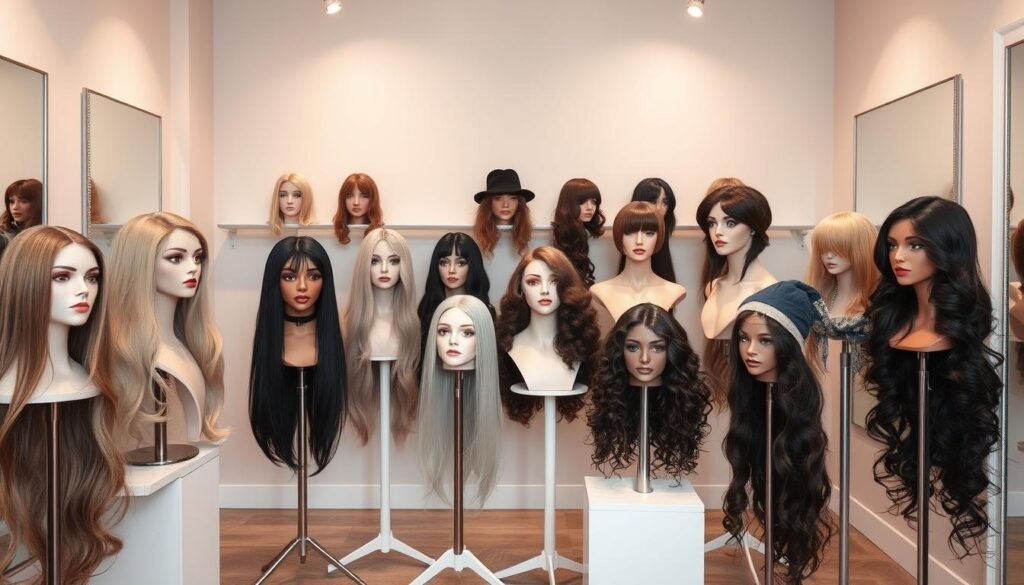Did you know about 2% of people have alopecia areata? This condition causes sudden hair loss. It’s important to care for your hair and scalp with alopecia. People with alopecia look for tips and products to help them. The impact of losing hair isn’t just physical. It can deeply affect emotions, making self-care very important.
We aim to share useful insights on how to handle alopecia. You’ll find advice and product suggestions to keep your hair and scalp healthy. These tips can boost confidence and help those with alopecia stay strong. For more on self-care practices, check out this comprehensive resource.
Key Takeaways
- Alopecia affects around 2% of the population, highlighting the need for informed care.
- Emotional support is just as vital as physical care when managing hair loss.
- Practical tips can significantly improve the daily management of alopecia symptoms.
- Choosing the right hair loss products can help maintain scalp health.
- Self-care routines promote confidence and overall well-being for those with alopecia.
Understanding Alopecia and Its Impact on Hair
Alopecia leads to hair loss and comes in different types. The well-known form is alopecia areata, which causes sudden hairless patches. Another kind, alopecia totalis, results in losing all hair. Androgenetic alopecia, affecting both genders, is passed down through families. These types have unique challenges and triggers, affecting those who have them differently.
These conditions often involve the immune system attacking hair follicles, leading to hair falling out. Inflammation also plays a key role, disrupting the normal hair growth cycle. It’s important for people with these conditions to understand these processes.
The effects of alopecia aren’t just physical. People with it often face self-esteem problems, impacting their emotional health. Knowing about alopecia’s impact helps them handle their condition better, finding ways to deal with it emotionally and physically.
The Importance of Scalp Care for Alopecia
Scalp care is key when dealing with alopecia. It’s critical to keep the scalp clean and nourished. This helps avoid dirt and oil build-up, which might cause irritation or infections. Using gentle cleansers made for sensitive skin is crucial to prevent discomfort.
Keeping the scalp hydrated is also very important. Dry conditions can worsen alopecia, so it’s necessary to use special moisturizing products. These products should be soothing and help keep the skin’s natural balance.
Adding scalp massages to your routine is beneficial too. It boosts blood flow to the hair follicles. This might help bring back hair growth and keep the scalp healthy. Taking good care of your scalp can make dealing with alopecia easier and support hair regrowth.
Caring for Your Hair and Scalp with Alopecia
People with alopecia need a careful daily hair care routine. This routine should focus on scalp health and keeping hair in good shape. Choosing the right products is key to promote health and reduce hair loss. Proper scalp cleansing and moisturizing techniques are very important for hair health.
Daily Hair Care Routine
Anyone suffering from alopecia should have a custom hair care routine. It usually means washing your hair every few days to keep it clean but not dry it out. This routine might also include using leave-in treatments to fight dryness. Picking gentle hair products made for sensitive scalps is vital. Using the right conditioner helps keep your hair hydrated and protected from damage.
Gentle Cleansing and Shampoo Options
Choosing the right shampoo is crucial to avoid irritating your scalp. Look for sulfate-free shampoos for a soft cleansing. These shampoos clean away oil and buildup safely. You should shampoo as often as your scalp needs, finding the right balance. Also, lukewarm water is better than hot to avoid irritation.
Adding these soft cleansing methods will improve your hair care routine, making your hair healthier. For more alopecia hair and scalp care tips, visit this guide. You can learn more about treatment options at this resource.
Popular Alopecia Treatments
Alopecia can really shake up someone’s confidence. The good news is, there’s hope. Available treatments range from topical solutions, oral medications, to natural remedies. They can help bring back hair and improve scalp health. This encourages those with alopecia to take control of their hair care journey.
Topical Treatments
Topical solutions are usually the first step for alopecia. Minoxidil is one common choice, coming in foam or liquid. Besides minoxidil, there are corticosteroids. They fight inflammation and help hair grow. Remember, sticking to a routine is key to seeing results.
Oral Medications
Oral medications are another path for hair loss management in alopecia. Men may use Finasteride. It targets a hormone that causes hair to thin. Women might get prescribed anti-androgens to tackle hair loss. Always talk to a doctor to find the right medicine for you.
Natural Remedies to Consider
Some prefer natural remedies in their fight against alopecia. Essential oils like rosemary and peppermint are popular for hair growth. Also, biotin and saw palmetto supplements support hair health. These natural options can complement traditional treatments well.
| Treatment Type | Examples | Form | Typical Use |
|---|---|---|---|
| Topical Solutions | Minoxidil, Corticosteroids | Foam, Liquid | Applied directly to the scalp |
| Oral Medications | Finasteride, Anti-androgens | Pills | Taken daily per prescription |
| Natural Remedies | Essential Oils, Biotin | Topical, Supplements | Used as required for topical and daily for supplements |
Hair Loss Support: Finding the Right Products
Finding the right hair loss products is key. Look for items that boost hair health. They should also make the scalp healthier.
There are many effective choices:
- Serums: These are light and get into the scalp well. They have helpful stuff like biotin and minoxidil. Brands like Rogaine and Nioxin have good ones for thin hair.
- Hair Masks: These masks bring back moisture and strength. SheaMoisture and Olaplex make some good ones.
- Shampoos and Conditioners: Products by Aveda and Paul Mitchell are great for scalp. They also help stop hair from breaking and make it shiny.
Using these products regularly is a good move. They help keep your hair and scalp healthy. That way, your hair stays strong, ready for more treatments if needed.
Wig Options for Those with Alopecia
Wearing a wig can massively boost the spirits of someone dealing with alopecia. There are many wig choices out there. Picking the right one means thinking about what looks good, feels comfortable, and meets practical need. This boosts a person’s confidence and everyday life.
Knowing what goes into selecting a wig helps people find the perfect match for their needs.
Choosing the Right Wig
Several important factors come into play when picking a wig. They ensure you’ll be happy and comfortable with it:
- Material: Wigs can be synthetic or made from human hair. While human hair looks real and is versatile, synthetic wigs are budget-friendly and simple to care for.
- Fit: It’s crucial to get a snug fit for comfort. Adjustable straps help fit various head sizes.
- Style: Choosing a style that reflects your personal look can make a big difference. Look for styles that highlight your best features and boost your confidence.
- Color: You can stick with your natural hair color or try out new ones for fun self-expression.
Maintenance Tips for Wigs
Caring for your wig properly keeps it looking fresh and real. Follow these maintenance tips:
- Wash it with a gentle, sulfate-free shampoo made for wigs. This protects the fibers.
- Let the wig air dry to prevent damage. Heat can harm it.
- Keep your wig on a stand to maintain its shape and avoid knots.
- Using special wig products helps keep it shiny and soft, whether it’s synthetic or human hair.

Taking these steps ensures a satisfying wig experience. It gives people dealing with hair loss personalized options that meet their needs.
Lifestyle Modifications to Support Hair Health
Making positive changes in your life can greatly improve your hair’s health. It’s important to adopt several habits to fight hair loss effectively. Quitting smoking does wonders for your whole health, and it benefits your hair too. Cutting down on alcohol helps keep hydration levels up, crucial for strong hair.
Enough sleep is key for the body’s natural repair work, which includes fostering healthy hair growth. Regular exercise is also essential. Being active boosts blood flow, ensuring hair follicles get the nutrients they need. These benefits aren’t just about looking good—they also make you feel good inside.
- Stay Hydrated: Drinking plenty of water is key for maintaining hair strength, a top tip for hair health.
- Balanced Diet: Eating foods full of vitamins and minerals helps make hair strong.
- Stress Management: Cutting down on stress can help prevent hair loss.
By adopting these lifestyle changes, you can better manage alopecia. Sticking with these habits lays the groundwork for healthy hair. Keep at it, and you’ll see great results, proving that a comprehensive approach leads to better health.
Stress Management Techniques for Alopecia
Managing stress is key for good health, especially with alopecia-related hair loss. Effective stress strategies improve well-being and hair health. There are methods including mindfulness and exercise to fight stress.
Mindfulness and Relaxation Methods
Mindfulness reduces stress. Meditation and deep breathing create calm and balance. Adding these to daily life helps manage thoughts and feelings. Other helpful practices include:
- Yoga: Merges movement and breath for relaxation.
- Guided Imagery: Forms peaceful images in the mind, easing anxiety.
- Progressive Muscle Relaxation: Tenses then relaxes muscles to ease stress.
Physical Activities to Reduce Stress
Physical exercise is great for stress relief. It boosts mood and health. Enjoyable activities are best for lowering stress. Some good choices are:
- Walking: Simple and effective for mental clarity and stress reduction.
- Swimming: Works the whole body and relaxes with the water.
- Group Sports: Allows bonding and focus on fitness together.

Using mindfulness and exercise helps with stress. For those dealing with alopecia, these methods support coping and mental well-being.
The Role of Nutrition in Hair Regrowth
Nutrition is key to getting your hair to grow back and keeping it healthy. Eating well helps your hair by giving it what it needs. If you want better hair growth, pay attention to your diet.
Essential Nutrients for Healthy Hair
Some nutrients really help your hair grow. Here’s what you need:
- Vitamin A: It helps with cell growth and keeps hair moisturized.
- Vitamin C: This antioxidant fights stress in hair roots.
- Vitamin D: It helps with new hair growth.
- Vitamin E: Boosts scalp health by improving blood flow.
- Omega-3 Fatty Acids: Makes hair thicker and healthier.
Foods to Include in Your Diet
For better hair, eat these foods:
| Food | Nutritional Benefit |
|---|---|
| Leafy Greens | Full of vitamins A, C, and iron for your hair. |
| Nuts and Seeds | They have omega-3s and vitamin E. |
| Fatty Fish | Packed with omega-3s and vitamin D. |
| Quinoa | Loaded with protein and vitamins. |
Connecting with Support Groups for Alopecia
People with alopecia face many challenges. Joining support groups helps by sharing feelings and experiences. This creates a bond that builds resilience through understanding.
Support from the community is key. It lets people connect with others who understand their situation. Group members often share tips and strategies for dealing with hair loss.
Getting emotional support makes life better. Being in a group reduces the feeling of being alone. It offers comfort and hope, leading to a happier outlook.
Many resources exist for finding support. Now, online platforms help people connect from home. Also, organizations offer both in-person and online meetings for everyone.

| Support Group Name | Format | Frequency | Website |
|---|---|---|---|
| Alopecia Areata Foundation | In-person & Online | Monthly | Link |
| Wigs for Kids | Online | Weekly | Link |
| Follicular Society | In-person | Bi-Weekly | Link |
| Light of Hope | Online | Monthly | Link |
Being part of a support group is very helpful. Finding the right group can change how you deal with alopecia. It lets people flourish, even with their struggles.
Conclusion
Taking care of hair with alopecia is key for both looks and self-confidence. The path might be tough. But, using the correct treatments, keeping up with hair care, and changing your lifestyle can make a big difference. We must not forget that healthy scalp and hair can bring better results.
Wigs and community groups are super helpful for those dealing with hair loss. Luckily, there are many resources and products out there to help. For more insights on hair and scalp health, check out studies on the National Institutes of Health’s website.
In the end, it’s about embracing the help available and seeking support when it’s needed. By following the tips shared, people with alopecia can feel supported. It shows they’re not facing hair loss alone.